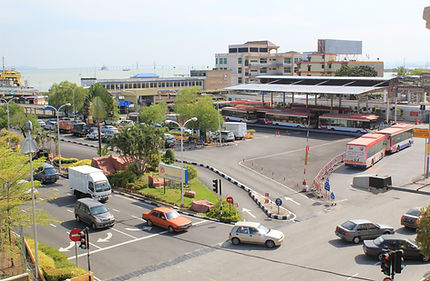
1. China Street
2. Beach Street
3. Weld Quay
4. Wisma Kastam
5. Bangunan Wawasan
6. Pengkalan Raja Tun Uda Ferry Terminal
7. Clan Jetties

1. China Street
Originally linked to the shore, the goods would be unloaded and purhcased on the shore via ghauts on China Street. Ghaut, in Hindi, means steps leading down the sea. The orientation of the street were altered, the street was slightly bent to the left during the land reclamation. It was believed that the placement of clocktower on Wisma Kastam (formerly known as Malayan Railway Building) was British's method of disrupting the fengshui of the Chinese Community.
Now, shoplots of different architectural styles are located in China Street. Some of the shoplots are still operating, whereas some are abandoned.

2. Beach Street
Godowns were mostly built in Beach Street for storage of goods. Between 1880s and 1930s, Penang was experiencing economic boom. Beach Street, at a strategic location, was the centre of trade with offices, banks and godowns. Beach Street was named by the locals as "Tho Kho Kay" which means warehouse street. Ban Hin Lee Bank, founded by Sir Yeap Chor Ee, was located in Beach Street. It was later bought over by CIMB Bank.
Now, Beach Street is occupied with offices and banks, such as OCBC Bank. Restaurants and cafes are located in Whiteaways Arcade. Every Sunday, Beach Street is occupied with communal activities via a programmed named 'Project Occupy Beach Street'.

5. Bangunan Wawasan
Yeap Chor Ee owned a total of three buildings along China Street Ghaut: Wisma Yeap Chor Ee, UAB building and Bangunan Wawasan. There were two major functions of these buildings which were warehouse for mercantile business and secured facility for the valuable tin ingots.
Bangunan Wawasan, previously known as Wawasan Open University Regional and Learning Office. Similarly, it was built in the 1930’s . It used to house a clinic and later fucntioned as a nighspot. As of March 2013, it is occupied by Disted College School of Hospitality.

4. Wisma Kastam
It played its role as Malayan Railway Building. It was a railway station without a rail or platform because the building housed administration offices, ticket booth and a railway restaurant with Bar & grill. Passengers boarded the Railway Ferry steamers to Butterworth to catch the train after purchasing tickets at the Railway Building.
It was then occupied by Customs Departement in the late 1960's. It was the tallest building in Penang with its clock tower before Komtar was constructed. Like Wisma Yeap Chor Ee, it incorporates art deco and classical elements with its ionic columns and pane windows .

6. Pengkalan Raja Tun Uda Ferry Terminal
Victoria Pier, which was built at the end of 19th century, in honour of Queen Victoria, was replaced by Pengkalan Raja Tun Uda Ferry Terminal. The ferry terminal was named after Raja Tun Uda Al-Haj bin Raja Muhammad, the first Governor of Penang of the newly independent Malaya.
Pengkalan Raja Tun Uda connects the people of Penang and Butterworth, where Pengkalan Sultan Abdul Halim is located. The service operates from 5.30 am to 1.00am. It takes about 15 to 20 minutes to cross the strait.

7. Clan Jetties
The poor Chinese immigrants,from the south-eastern coast of China, built the clusters of wooden house. They work near the port during the nineteen century. They were in poverty and in order to change their living conditions, they brought their families over and built houses at the waterfront. As time goes by, each jetty was indentified and dominated by certain clans. Fights and disputes occurred during the past due to the constant rivalry over the monopoly of work consignment.
These clusters of wooden house are still home to hundreds of people. Their lifestyles have changed gradually. It is a famous tourism attraction in Georgetown now.

3. Weld Quay
In 1883, the British carried out a land reclamation project along beach street. Dozen of wharves, piers and jetties sprouted from the new land mass which was named Weld Quay after Sir Frederick Aloysius Weld, Governor of the Straits Settlement (1883-1889) (book). However, only lighters (ie: Chinese Twakows, Indian Tongkangs, Malay schooners, fishing boats, Bugis vessels from Celebes) were suitable for the jetties. Deep berth vessels are required to anchor off shore and unload their goods onto the lighters to be carried on shore.

